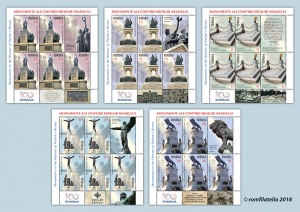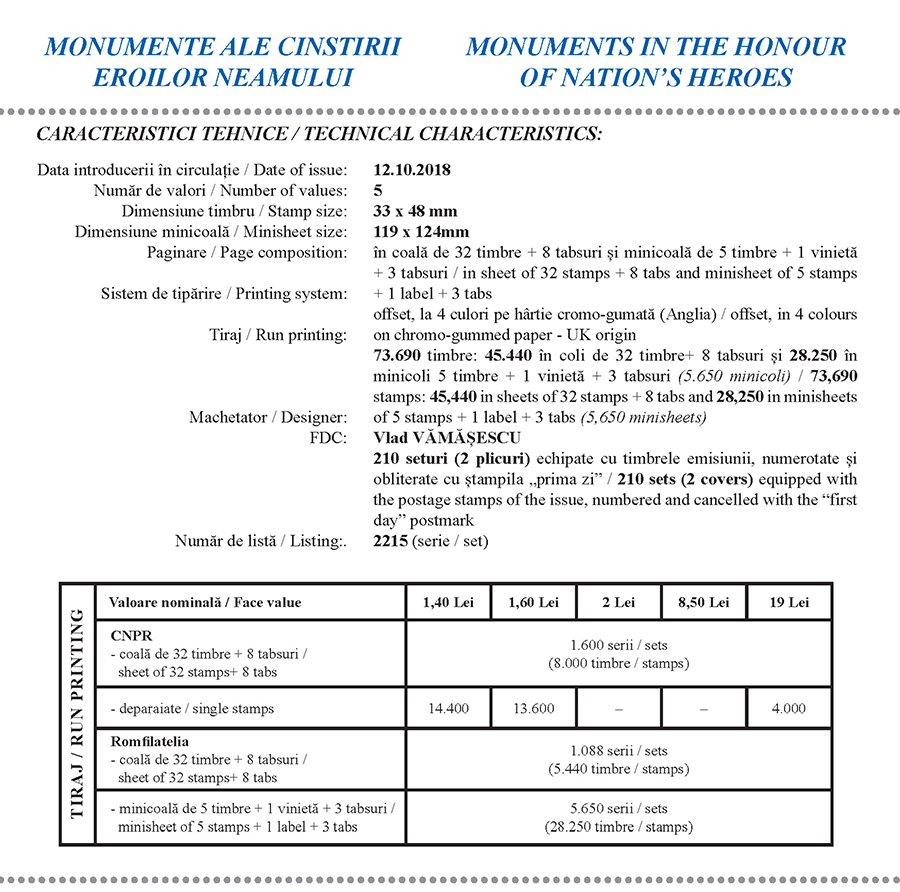 In the Centenary year of the Great Union, as a sign of respect and gratitude for the sacrifices of our forefathers who died in the line of duty during the World War I, Romfilatelia introduces into circulation the postage stamp issue Monuments in the Honour of Nation’s Heroes.
In the Centenary year of the Great Union, as a sign of respect and gratitude for the sacrifices of our forefathers who died in the line of duty during the World War I, Romfilatelia introduces into circulation the postage stamp issue Monuments in the Honour of Nation’s Heroes.
On the stamp with the face value of Lei 1.40 is represented the Monument to the Railway Heroes. The Monument to the Sanitary Heroes is illustrated on the stamp with the face value of Lei 1.60. On the stamp with the face value of Lei 2 is represented the Tomb of the Unknown Soldier. The Monument to the Air Heroes is illustrated on the stamp with the face value of Lei 8.50, and the stamp with the face value of Lei 19 presents the Monument to the Heroes of the Engineer Arm – the Lion.
The Monument to the Railway Heroes, located in the North Railway Station Square in Bucharest, the work of the renowned sculptors Cornel Medrea and Ion Jalea, was inaugurated in May 1943 to honour the memory of the heroes died in the line of duty at the front in the World War I.
The bronze cast statue group, mounted on a granite-plated concrete pedestal, is made up of several characters. A woman, who symbolizes the Homeland, holds a crown of laurels above the head of a railway worker. Next to her, on one side of the plinth, there are two railway workers, and on the other side, a Romanian soldier, dressed in campaign outfit, protecting a woman and her child.
The following inscription appears on the main facade of the pedestal “Railway Heroes – 1916-1918”. On the side of the plinth, the following inscription is engraved in white marble: HOMAGE AND GRATITUDE TO THE RAILWAY AND TRANSPORT MILITARY HEROES OF THE ROMANIAN ARMY WHO SACRIFICED THEMSELVES FOR THE CAUSE OF THE NATION.
The Monument to the Sanitary Heroes, located in the vicinity of the Faculty of Medicine in Bucharest, was built in 1932, in memory of the Romanian medical body that saved lives during the World War I. The work belongs to the Italian sculptor Raffaello Romanelli. On a concrete plinth, covered with travertine, a statue made of bronze is raising, in the upper part of the plinth being depicted, in a high-relief, scenes from the activity of the sanitary body during the war: stretcher bearers gathering the wounded people from the battlefield, military surgeons operating, a campaign hospital, a charity sister who is dressing a wounded etc. One of the bas-relief panels on the monument illustrates Queen Marie, as a nurse, Prince Nicholas of Romania, in a uniform of cadet, and Princess Elizabeth of Romania, also in nurse uniform. On the main pedestal facade, on a travertine plate, it is engraved with embossed font: TO THE SANITARY HEROES 1916-1920.
The construction of the first line of the Bucharest subway required the dismantling of the monument, which was restored in 1981 and located in the same place.
The Tomb of the Unknown Soldier, located in “Carol I” Park in Bucharest, is a funerary-commemorative construction that symbolizes the sacrifice of all the anonymous soldiers who shed their blood during the World War I for the Unification of Romania.
The ceremony of the bones’ deposition of the Unknown Soldier took place in Marasesti on May 14th, 1923. The sarcophagus arrived in Bucharest on May 17th, 1923, the burial ceremony taking place in a festive setting, in the presence of the Royal Family, of the members of the Government and a large audience, on the plateau in front of the former headquarters of the Military Museum in “Carol I” Park.
In 1927, the project of the funeral ensemble was carried out, according to the plans of the sculptor Emil Wilhelm Becker. At the same time, through the care of “Cultul Patriei” (“Homeland Cult”) Association, a candle was lit whose flame burns even today, day and night.
The Tomb of the Unknown Soldier was dismantled on the night of December 22nd to December 23rd, 1958 and moved to Marasesti Mausoleum, being returned to Bucharest in 1991 and relocated to the original location, in “Carol I” Park.
Another work located in Bucharest, in Aviatorilor Square, built to honour the memory of the Romanian military and civilian airmen, is the Monument to the Air Heroes. The statue made of bronze, a work by Iosif Fekete, Lidia Kotzebue and Arnold Cencinschi (called Borgo Prund), has a height of 5 m and a weight of 5 t.
The monument was built between 1930 and 1935. The statue illustrates the flying man with deployed wings, a symbol of defeat of death through heroism, around whom there are three fallen airmen. On the plinth, with a height of 7 m, made of Banpatock stone from Apuseni Mountains, there are the badges, the helmet, the equipment of the airmen, and the names of the 270 Romanian airmen died until the time of the inauguration, carved in 13 bronze plates.
The Monument to the Heroes of the Engineer Arm – the Lion from Bucharest, located in the crossroad of Iuliu Maniu and Geniului Avenues, was also built in memory of the heroes died in the line of duty during the World War I. The monument was built at the initiative of General Constantin Stefanescu-Amza, commander of the Military Engineering Schools and Training Centre, who launched the campaign for collecting the necessary funds, also managing the contest for the builder selection, won by the sculptor Spiridon Georgescu. It was inaugurated on June 29th, 1929, during a grand festivity, in the presence of His Royal Highness, Prince Nicholas, representatives of the Government etc.
On the plinth of the monument there are mounted bronze plates that reproduce moments from the activity of the military engineers, as well as four statues, also made of bronze, depicting combat engineers. The pedestal is surmounted by the statue of a bronze lion, with a length of 5.40 m, a height of 4.40 m and a weight of 6 t. It is depicted sitting on a cannon and a helmet over which is unfurled a battle flag, all belonging to enemy troops, symbolizing the strength, stoutness and bravery that showed the Romanian army in the World War I, during the campaigns of the years 1916-1918, especially in the battles of Oituz, Marasesti and Marasti.
In the four corners of the statue ensemble, there are four soldiers – a scout, a railway operative, a pontonier and a telephonist – suitably equipped for combat missions. Also, on the left and right sides of the main plinth, two emblems are fitted, representing the military engineer’s weapon logo at that time.
The following inscription appears on the side of the plinth facing the square: TELL FORTHCOMING GENERATIONS THAT WE HAVE MADE THE SUPREME SACRIFICE ON THE BATTLEFIELDS TO COMPLETE THE NATION.
On the First Day Cover of the issue is illustrated the Arch of Triumph, built between 1921-1922, symbol of Romania’s victory in the World War I.
Romfilatelia thanks the Monuments and Heritage Tourism Administration in Bucharest, the National Office for the Cult of Heroes and Mr. Francisc-Attila Vaida for the documentary and photographic support granted for the achievement of this postage stamps issue.



